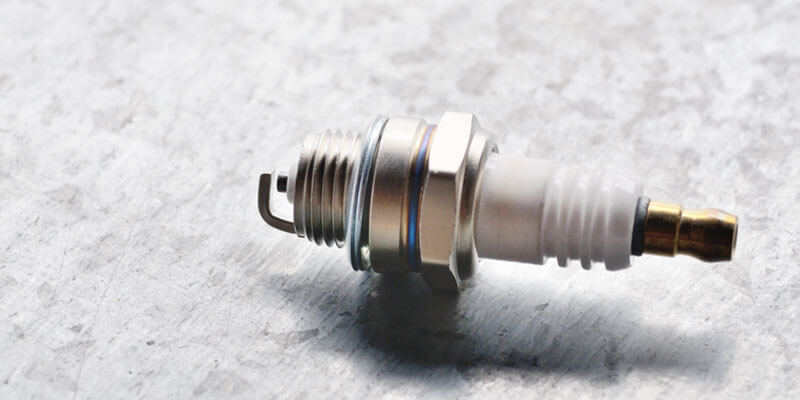You have been running your two-wheeler for about a year, but maybe you don’t know how to read a 2-stroke spark plug. Well, learning the process of reading two-stroke spark plugs is not rocket science. Knowing how to read spark plugs will enhance the opportunity to take more care of your bike.
You may suffer from low speed or weird sounds while riding your bike. For this, every time you go to a mechanic, you need to pay him extra money, and after some time, he comes out with a solution, “your spark plug is not working well.” Annoying to listen to, right?
To get rid of that, we will show you how you can check your spark plug just by seeing the color, sound, and NGK numbers all by yourself.
Why Do We Need to Read a Spark Plug?
Suppose you plan to go on a long drive date or a night out chilling with your friends. Naturally, your car is the main part of this full planning. Now, when you are about to start the long drive party, if you face the following, your drive will no longer be a fun part:
- Poor acceleration
- Hard Starting
- Vibration
- Excessive fuel consumption
- Bad Engine light indicator
We know the pain of facing these problems while riding. You may suffer from these problems due to a bad spark plug. That’s why you need to do 2 stroke spark plug diagnosis regularly.
Please do routine maintenance of your spark plug. Doing routine maintenance will give you an idea of how your engine is running. Checking 2-stroke dirt bike spark plug reading also makes you aware of anything wrong with your engine.
How to Read a 2-Stroke Spark Plug: Step-by-Step Procedure
Time required: 15 – 20 minutes
You may hear from someone that only checking the color of the spark plug can give you an idea of your spark plug. It’s true in a narrow sense, but in a broader sense, you need to check heat range, pre-ignition, and more to get the full idea of your spark plug condition.
We know you never want half-fun, do you? Like that, your 2-stroke spark plug also needs a full diagnosis.
For that, you need to check with all the facts step by step whether your spark plug is perfectly working or not. Here you go, with the step-by-step procedure of reading a 2-stroke spark plug.
Step 1 – Color Test
Spark plug mainly helps to drive your car’s engine. It starts with the ignition from the air and fuel mixture. The air and fuel burn left a color mark on your engine’s spark plug. This color can be brown, dark black, or nothing. These different colors tell different stories of your spark plug condition.
In the tip portion of the spark plug of your thread, if you see brown color, it indicates a good mixture of air and fuel inside the engine. And, the perfect ratio of air and fuel says your car that, boy! You passed the first test!!
But, if you see black color in the top portion of your thread, then the air: fuel mixture is in a rich condition. You can also see no color. No color means, in that place, no ignition happened, and the spark plug is in a lean condition.
Don’t think that your full spark plug will show only one color entirely. No mate! All three colors can be present on the top of the spark plug, and it gives you an idea of where a good mixture happened and where not.
Step 2 – Detonation
Have you ever heard any weird knocks? Knock! Sound while riding your vehicle? If not, you are lucky now. If yes, you may have already faced issues regarding the spark plug.
Whether your answer is yes or no, you need to know those two spark plugs so that you can understand instantly that your spark plug is in trouble.
Due to heavy driving, electrodes and insulators may attach. This attachment is produced due to the melting. If melting is present between electrode and insulator, then detonation occurs in the spark plug.
You may also find detonation problems if some black or silver threads are present under or below a portion of the gasket. You can understand this better by doing a stroke plug chop test. We will discuss the chopping test later.
Step 3 – Pre-Ignition Test
In a spark plug, you see a cap-like element above the electrode. It is called the ground electrode, which is the highest element of the spark plug. To read your 2-stroke spark plug, you also need to check this element carefully.
Read: How to Test a Spark Plug With a Battery?
If you see more than half mm. light color in the front portion of the ground electrode after a test drive, then your spark plug needs help. After this pre-ignition test, don’t take much time to help your unhealthy spark plug.
Step 4 – Heat Range Test
Have you ever investigated your spark plug shape closely? Can you say the ground electrode of the spark plug looks like an English letter? Yes, it looks like the reverse “L.” The front portion is called the tip, and the back is called the base. And the other is the bent area.
You already know that plating burns due to the heat while riding your 2-stroke vehicle. This burn plating will help us know our spark plug’s condition. The followings are the result of the heat range test:
- Ideal = Plating burnt at the bent portion of the ground electrode
- Too Hot = Plating burnt at the base portion
- Too Cold = Plating burnt at the end of the ground electrode tip
Step 5 – NGK Spark Plug Reading
If you use an NGK spark plug, a number may exist on the body of the spark plug. It consists of numbers like “br9eg”. You may be thinking, what on earth does this number want to mean?
The NGK spark plug reading indicates the condition of the spark plug. It is related to the above-mentioned heat range test.
The number of the NGK spark plug reading tells the spark plug style. For your easy understanding, the styles are given below –
- 9 means colder style
- 8 means the standard style
- 7 indicates hotter style
From your NGK spark plug reading, you will get an idea about which type of heat range you may get.
Step 6 – 2 Stroke Plug Chop
All the previous tests just examined the spark plug exterior surface. But to confirm fully about your spark plug, you can do a chop test. To do that, you need to chop the exterior gasket of the 2-stroke spark plug.
Take a sharp knife or hacksaw to cut the exterior surface carefully. Before that, make sure you hold the spark plug firmly through any holding tool. Are you finishing the chopping? Great! Now examine properly.
You are seeing a brown or black color layer at the surface of the insulator. Can you please take a vernier caliper/scale? From your measuring, if you find out that the layer widens more than 2 mm, then the spark plug has a rich air and fuel mixture; for less than 2 mm, it is in a lean condition.
In the detonation step, we committed to you to explore more about detonation through chop tests. Here we go. In the bottom portion of the insulator, if you find any black or dark color spot, then detonation problems occur due to the faulty spark plug.
How Often Should You Change the Spark Plug on a 2-Stroke Engine?
Different manufacturers provide different lifetime and reliability to the spark plug. But it is always your task to follow preventive maintenance. The more often you do the maintenance task, the longer you can use the spark plug without issues.
It is better to clean your spark plug after every 1000 km ride. Generally, new spark plugs provide optimum service up to 7000 km. But, if you don’t allow oils to deposit on your spark plug, then you don’t need to worry about changing it up to 20,000-30,000 km.
FAQ
If you see a gray or tan color at the top of the thread, you can say that the 2-stroke spark plug is healthy.
If you find that your 2-stroke dirt bike spark plug feels wet, you need to understand that the spark plug is flooded with fuel, and an inappropriate mixture of air and fuel can damage it.
Conclusion
We hope that now you know how to read a two-stroke spark plug. It is better to read your 2-stroke spark plug before starting the main drive. You can do a test drive for 20-30 minutes and check the status of your spark plug.
Do you want more assurance? Okay, let’s do a half pass and check the spark plug reading and again do a full pass and take a reading. All, okay? Great! You are now all set to start the drive.

